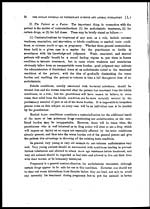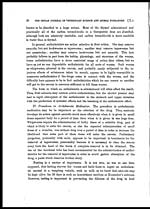Medicine - Veterinary > Veterinary colleges and laboratories > Indian journal of veterinary science and animal husbandry > Volume 1, 1931 > Part I (March 1931) > Use of drugs in the treatment of diseases caused by worms
(73) Page 39
Download files
Individual page:
Thumbnail gallery: Grid view | List view

TREATMENT OF DISEASES CAUSED BY WORMS 39
condition during this critical time, and allow them and the fœtus to benefit accord-
ingly. It is probable that the bad results in the way of abortions and miscarriages
in connection with anthelmintic treatments are associated at times with the use
of drastic purgatives rather than the action of the anthelmintic.
(2) Contraindications for individual drugs are of many sorts, and follow from
the particular action of the drug in question on the host to be treated. In some
instances we have alternative drugs having different actions on the host, and one
of these may be indicated for use in connection with contraindications for another
drug or other drugs. One might say in general that one avoids gastro-intestinal
irritants in the presence of gastro-enteritis, chlorinated hydro-carbons causing
hepatic necrosis in the presence of serious liver injury, drugs unfavourably affecting
the nervous system in the presence of epileptic conditions, etc. All these rules are
subject to modification, as we may at times have such results as improvement in
cases of inadequate liver functioning after the administration of a drug which
injures the liver but stimulates a chronic indolent trouble into an acute condition
going on to repair and recovery.
(3) Contraindications for full doses are frequently encountered. In this connec-
tion one should consider the apparent age, rather than the chronological age, of
an animal, in judging the dose which will be tolerated, and base the dose on size,
general condition, and other things. Gross helminthiasis in young animals is a
condition which may call for diminished doses and repeated treatments, rather
than one full therapeutic dose. Occasionally the killing of large masses of ascarids
may cause intestinal obstruction from clumps of worms in weak animals with an
atonic intestine too feeble to remove these masses. The selection of the dose
is emphatically a matter calling for sound information and good judgment on the
part of the practitioner, and no specific instructions can take the place of such
information and judgment.
III. The Anthelmintic as a Factor. The older books define an anthelmintic as
a relatively insoluble drug which remains for the most part in the digestive tract,
poisons the worms, and then is swept out by a purgative before any considerable
amount of absorption can occur, the patient being thus little affected. This defines
a somewhat ideal sort of anthelmintic for worms in the digestive tract, but does
not represent our present concept of anthelmintics or the actual facts. Anthelmin-
tics at present include drugs used to destroy worms in places outside of the diges-
tive tract, where absorption of the drug from the digestive tract is essential or
where the drug is actually given intravenously or in some other manner which
precludes the idea that it will not be absorbed and have systemic effects. More-
over, the anthelmintics in use for removing worms from the digestive tract are
Set display mode to: Large image | Zoom image | Transcription
Images and transcriptions on this page, including medium image downloads, may be used under the Creative Commons Attribution 4.0 International Licence unless otherwise stated. ![]()
| Permanent URL | https://digital.nls.uk/75226013 |
|---|
| Description | Covers articles from 1931. |
|---|




